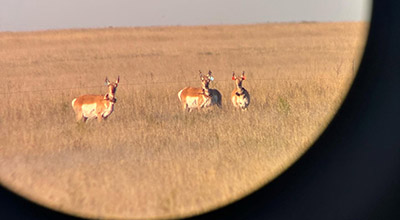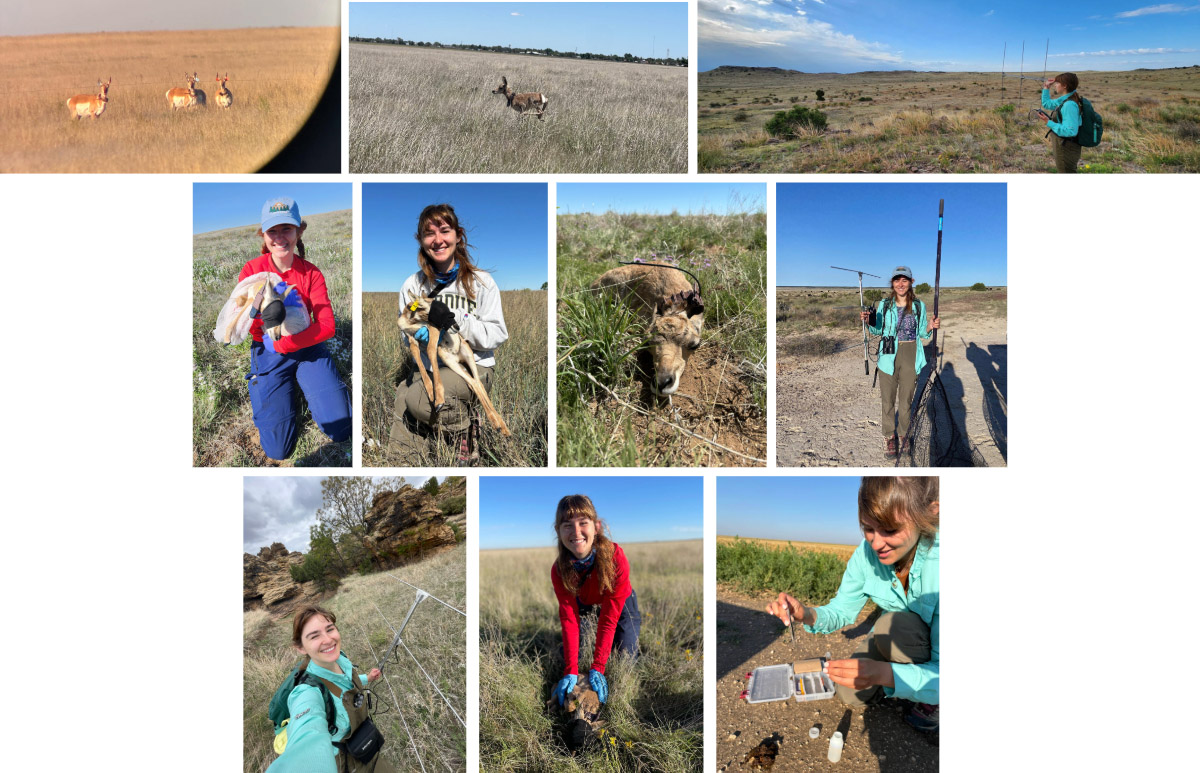FNR Field Report: Emma Johnson
Students from Purdue Forestry and Natural Resources took their classroom knowledge to the field for summer internships and paid positions across the country, gaining valuable experience, hands-on training and career guidance. The FNR Field Reports series offers updates from those individuals as their positions draw to a close.
for summer internships and paid positions across the country, gaining valuable experience, hands-on training and career guidance. The FNR Field Reports series offers updates from those individuals as their positions draw to a close.
Emma Johnson, a senior wildlife major, spent the summer working as a pronghorn field technician on the Oklahoma Pronghorn Project. In her position, the Luray, Virginia, native used radio telemetry to track collared pronghorn does and observe them to check pregnancy status and subsequently capture, process and collar fawns to track fawn survival.
The position also required Johnson to observe pronghorn behavior during drone surveys, conduct fecal pellet samples from adults and perform field necropsies on deceased pronghorns to investigate the cause for their mortality, including taking tissue samples to test for diseases.
“I learned so much about the ecology of pronghorn antelope from this job: their predator responses, their tendency to not jump fences, how they interact with other individuals in their herd and the behavior of pronghorn mothers,” Johnson explained. “Just being out in the field, observing your study species for hours a day through a scope in a truck, you learn a lot about them. I feel that this is the best way to understand the plight of pronghorn: to be with them in their environment and learn from them. I also gained animal handling skills and learned how to trust my instincts in the field. When capturing fawns and collaring them, you want to be as fast as possible as to not stress them out.”
Spending time with a new species was one of the perks of the position, but also brought to light the reality of life and death of the animals.
“My favorite part of the job was just getting to work with pronghorn,” Johnson said. “I had never seen one until this position. It was amazing getting to work with a Pleistocene relic that persists today despite anthropogenic pressures. Just observing them in the wild was so beautiful. Another favorite part of my job was getting to process the fawns. They were so precious, and it was fun to watch them grow up.
“The most challenging part of the job was investigating mortality for fawns. It was difficult to process a live fawn one day, and then have to investigate a deceased one another day. While this was difficult, it reinforced the need for a study, like the one I was working for, to study fawn survival and mortality causes for pronghorn in Oklahoma.”
Seeing nature and agriculture in action side by side provided a standout moment for Johnson.
“One experience that stands out to me from this summer was when I witnessed the end of a pronghorn birth in a crop field,” Johnson shared. “Just right afterwards, a tractor drove by in the background, ploughing through a nearby field. I was looking through a scope, focusing on this pronghorn and the twins she had just given birth to, while simultaneously seeing a farmer work the field right next to her. It was a picture of humans and wildlife inhabiting the same place, and the resilience of this pronghorn to give birth in a landscape changed by agriculture. That image has stuck with me today.”
given birth to, while simultaneously seeing a farmer work the field right next to her. It was a picture of humans and wildlife inhabiting the same place, and the resilience of this pronghorn to give birth in a landscape changed by agriculture. That image has stuck with me today.”
The field technician position with the Pronghorn Project, which she found on the Texas A&M job board, allowed Emma to apply her Purdue Forestry and Natural Resources classwork in the field, specifically her wildlife techniques class.
“Studying wildlife populations came to life this summer when I was actually collaring animals and using radio telemetry,” Johnson shared. “I also feel like the field jobs I have had in FNR equipped me and prepared me to be confident in the field.”
For the past two years, Johnson has worked on projects with Dr. Pat Zollner.
The first project, in collaboration with the Indiana Department of Natural Resources, is to estimate white-tailed deer density across the state of Indiana, including some in areas where epizootic hemorrhagic disease (EHD) outbreaks have occurred. Since the spring of 2024, Emma has served as the leader of a group of undergraduate students on the FNR flight crew, which collects data for the project by operating an infrared camera from a Sky Arrow aircraft over at Purdue Aviation.
“It is a lot of fun collaborating with the aviation department and getting to fly over places in Indiana where EHD outbreaks have recently occurred,” Johnson said.
EHD outbreaks have recently occurred,” Johnson said.
Johnson is now analyzing the footage the crew gathered last season, working in a dark room to see heat signatures.
“My apartment has become a dark lair for counting deer,” she joked. “I get to be like ‘that is a deer’ in my dark apartment. It is all very exciting.”
Johnson also is working on a separate undergraduate research project with Zollner and the Indiana DNR, which analyzes possible bias introduced by flight speed during aerial surveys.
“The point of the bias project is to inform wildlife managers and researchers about the most cost-effective way to estimate deer populations, and hopefully other species,” Johnson explained. “I also want to give a shoutout to PhD student Jonathan Brooks, who advises me in this project.”
Emma presented a poster about her work at the Midwest Fish and Wildlife Conference last year and also gave an oral presentation on her research at the Indiana Chapter TWS Conference, which won her the Best Flash Talk Award.
Prior to her work in the Zollner lab, Emma worked as an interpretive ranger for Colorado Parks and Wildlife in western Colorado the summer after her first semester at Purdue.
As a sophomore, she worked as a research assistant for Purdue Extension wildlife specialist Jarred Brooke, conducting pellet count surveys and measuring browse impacts of deer on vegetation to estimate white-tailed deer density at Martell Forest. The next summer, Emma worked with Brooke as a wildlife extension technician, traveling to various Purdue properties, deploying trail cameras, surveying vegetation and presenting information for environmental education camps at Purdue.
In addition to her work experience, Emma is involved with the Purdue student chapter of The Wildlife Society, for which she served as the student council representative last year. She also acted as secretary and student council representative for the Student Chapter of Environmental Education during the 2023-24 school year.
What the future holds for Johnson is still to be determined, but her summer position has made her career goals even more clear.
“Working on the pronghorn project solidified my desire become a wildlife biologist and to continue doing research after I graduate,” Johnson said. “There were so many days when I would be working in the field and think "Yep, this is why I chose to study wildlife."
 A collage of photos from Emma Johnson's summer as a pronghorn field technician with the Oklahoma Pronghorn Project. Top row (Left to Right): A group of pronghorns as seen through a scope; a pronghorn in a field; Emma holds an antenna during a radio telemetry survey. Row 2: Emma holds a fawn before processing and collaring; a pronghorn fawn with its radio collar; Emma holds her radio telemetry gear. Row 3: Emma in front of a rocky landscape with her telemetry gear; Emma with a fawn in the field; Emma gathers samples.
A collage of photos from Emma Johnson's summer as a pronghorn field technician with the Oklahoma Pronghorn Project. Top row (Left to Right): A group of pronghorns as seen through a scope; a pronghorn in a field; Emma holds an antenna during a radio telemetry survey. Row 2: Emma holds a fawn before processing and collaring; a pronghorn fawn with its radio collar; Emma holds her radio telemetry gear. Row 3: Emma in front of a rocky landscape with her telemetry gear; Emma with a fawn in the field; Emma gathers samples. 





